Evolutionary Game Analysis of Cross-Border E-Commerce Logistics Alliance Subject Considering Supply Chain Disruption Risk
Abstract
:1. Introduction
2. Analysis of Alliance Members’ Game Behaviors Considering Supply Chain Disruption Risk
3. Establishment of Evolutionary Game Model of Cross-Border E-Commerce Logistics Alliance
3.1. Model Basic Assumption
- (1)
- Model assumptions
- (2)
- Parameter Settings
3.2. Evolutionarily Stable Strategy Solution
- (1)
- Revenue expectation function construction
- (2)
- Evolutionary path analysis
- ①
- Analysis of the evolution path of cross-border e-commerce platforms
- (1)
- When occurs, holds for and , which means = 1 is the evolutionary stable strategy (ESS) for the cross-border e-commerce platform.
- (2)
- When occurs, holds for and , which means = 0 is the evolutionary stable strategy for the cross-border e-commerce platform. Based on this, the phase diagram of strategy evolution for the cross-border e-commerce platform is shown in Figure 2.
- ②
- Evolution path analysis of logistics service providers
- (1)
- When occurs, holds for and , which means = 0 is the ESS.
- (2)
- When occurs, holds for and , which means = 1 is the ESS. Based on this, the phase diagram of strategy evolution for the cross-border e-commerce platform is shown in Figure 3.
- ③
- Analysis of the evolution path of overseas merchants
- (1)
- When occurs, holds for and , which means is the ESS (Evolutionarily Stable Strategy).
- (2)
- When occurs, holds for and , which means = 1 is the ESS (Evolutionarily Stable Strategy). Based on this, the phase diagram of strategy evolution for overseas merchants can be seen in Figure 4.
- (3)
- Strategy stability analysis
4. Alliance Main Body Evolution Simulation Analysis
5. Conclusions and Trends
- (1)
- The reduction in the allocation coefficient of additional total costs for logistics service providers, the increase in overall losses due to customer complaints, and the platform’s compensation determination for merchants affected by supply chain risks all encourage logistics service providers to actively pursue service innovation strategies and motivate overseas merchants to actively participate in alliance cooperation. In addition, increasing the overall risk costs and opportunity costs for merchants will increase the cost of alliance cooperation among the three parties in the game, which is unfavorable for the development of cross-border e-commerce logistics alliances. At the same time, the penalties and potential losses imposed by the platform on logistics service providers when they receive complaints will not only enhance the platform’s control over logistics service providers but also reduce their enthusiasm for implementing service innovation strategies.
- (2)
- Typically, participants in an alliance are highly sensitive to exogenous variables that are relevant to themselves. The aforementioned study also indicates that the behaviors of participants and exogenous variables in the cross-border e-commerce logistics alliance will have varying degrees of impact on the management practices of such alliances. As the leading body of the alliance, cross-border e-commerce platforms should coordinate the participants and constrain the behaviors of the participating entities within the alliance by establishing reasonable incentives and penalty mechanisms. Simultaneously, a thorough analysis of the specific roles played by different exogenous variables in the cross-border e-commerce logistics alliance should be conducted to assess their respective impacts. Furthermore, the alliance and cross-border e-commerce platforms should further balance the interests of all parties to maximize the overall benefits, thereby safeguarding the comprehensive benefits of the cross-border e-commerce logistics alliance.
Author Contributions
Funding
Institutional Review Board Statement
Informed Consent Statement
Data Availability Statement
Conflicts of Interest
References
- Zhang, X.H. Collaborative research on cross-border e-commerce and cross-border logistics under the Belt and Road Initiative. Contemp. Econ. Manag. 2020, 34, 190–191. (In Chinese) [Google Scholar]
- Gentry, J.J. Logistics alliances: A source of competitive advantage. In Proceedings of the 1996 Academy of Marketing Science (AMS) Annual Conference, Phoenix, AZ, USA, 29 May–1 June 1996; Wilson, E.J., Hair, J.F., Eds.; Springer: Cham, Switzerland, 2015; pp. 90–99. [Google Scholar]
- Du, Z.P.; Qu, Y.X. Research on information cooperation mechanism of cross-border logistics alliance based on tripartite evolutionary game. Chin. Manag. Sci. 2023, 31, 228–238. (In Chinese) [Google Scholar]
- Li, Z.; Gao, G.; Xiao, X.; Zuo, H. Factors and Formation Path of Cross-Border E-Commerce Logistics Mode Selection. Sustainability 2023, 15, 3685. [Google Scholar] [CrossRef]
- Chen, N.; Yang, J. Mechanism of government policies in cross-border e-commerce on firm performance and implications on m-commerce. Int. J. Mob. Commun. 2017, 15, 69–84. [Google Scholar] [CrossRef]
- Wei, H.; Wu, F. Formation of Coordinated Alliance for China Railway Express Platforms Considering Logistics Cost Sharing. Transp. Res. Rec. 2023, 2677, 721–735. [Google Scholar] [CrossRef]
- Wang, Y.; Agyemang, M.; Jia, F. Resource Orchestration in Supply Chain Service-Based Business Model: The Case of a Cross-Border E-Commerce Company. Sustainability 2021, 13, 11820. [Google Scholar] [CrossRef]
- Du, Z.P.; Gong, X.L. Research status of operation mechanism of cross-border logistics alliance at home and abroad. Circ. Econ. China 2018, 32, 37–49. (In Chinese) [Google Scholar]
- Du, Z.P.; Fu, S.S.; Mu, D.; Wang, D.D. Multi-party behavior game research of cross-border e-commerce logistics alliance based on 4PL. Chin. Manag. Sci. 2020, 28, 104–113. (In Chinese) [Google Scholar]
- Wei, H.; Lee, P.T.-W. Designing a coordinated horizontal alliance system for China’s inland ports with China railway express platforms along the Silk Road Economic Belt. Transp. Res. Part E-Logist. Transp. Rev. 2021, 147, 102238. [Google Scholar] [CrossRef]
- Ji, M.; Li, F.; Xu, S.; Zhuang, Y.; Bair, T.; Bilgaev, A.; Guo, K. Potential for Economic Transition and Key Directions of Cross-Border Cooperation between Primorsky Krai (Russia) and Jilin (China). Sustainability 2023, 15, 4163. [Google Scholar] [CrossRef]
- Zhou, L.; Wang, J.; Li, F.; Xu, Y.; Zhao, J.; Su, J. Risk Aversion of B2C Cross-Border e-Commerce Supply Chain. Sustainability 2022, 14, 8088. [Google Scholar] [CrossRef]
- Liu, T. Improved PSS timing synchronization algorithm and IoT application in cross-border e-commerce risk identification. J. Intell. Fuzzy Syst. 2023, 45, 1325–1340. [Google Scholar] [CrossRef]
- Xie, S.X.; Yin, B.J. Risk prediction and strategic breakthrough of cross-border e-commerce logistics alliance under Sino-US trade friction. Circ. Econ. China 2019, 33, 73–82. (In Chinese) [Google Scholar]
- Giuffrida, M.; Mangiaracina, R.; Perego, A.; Tumino, A. Cross-border B2C e-commerce to Greater China and the role of logistics: A literature review. Int. J. Phys. Distrib. Logist. Manag. 2017, 47, 772–795. [Google Scholar] [CrossRef]
- Song, B.; Yan, W.; Zhang, T. Cross-border e-commerce commodity risk assessment using text mining and fuzzy rule-based reasoning. Adv. Eng. Inform. 2019, 40, 69–80. [Google Scholar] [CrossRef]
- Zhou, F.; Liu, Y. Blockchain-Enabled Cross-Border E-Commerce Supply Chain Management: A Bibliometric Systematic Review. Sustainability 2022, 14, 15918. [Google Scholar] [CrossRef]
- Liu, Z.; Li, Z. A blockchain-based framework of cross-border e-commerce supply chain. Int. J. Inf. Manag. 2020, 52, 102059. [Google Scholar] [CrossRef]
- He, Y.; Zhang, C.; Wu, B.; Yang, Y.; Xiao, K.; Li, H. A Cross-Chain Trusted Reputation Scheme for a Shared Charging Platform Based on Blockchain. IEEE Internet Things J. 2022, 9, 7989–8000. [Google Scholar] [CrossRef]
- Ren, S.; Choi, T.-M.; Lee, K.-M.; Lin, L. Intelligent service capacity allocation for cross-border-E-commerce related third-party-forwarding logistics operations: A deep learning approach. Transp. Res. Part E-Logist. Transp. Rev. 2020, 134, 101834. [Google Scholar] [CrossRef]
- Davis, D.F.; Friske, W. The Role of Public-Private Partnerships in Facilitating Cross-Border Logistics: A Case Study at the US/Canadian Border. J. Bus. Logist. 2013, 34, 347–359. [Google Scholar] [CrossRef]
- Kim, T.Y.; Dekker, R.; Heij, C. Cross-Border Electronic Commerce: Distance Effects and Express Delivery in European Union Markets. Int. J. Electron. Commer. 2017, 21, 184–218. [Google Scholar] [CrossRef]
- Valarezo, A.; Perez-Amaral, T.; Garin-Munoz, T.; Herguera Garcia, L.; Lopez, R. Drivers and barriers to cross-border e-commerce: Evidence from Spanish individual behavior. Telecommun. Policy 2018, 42, 464–473. [Google Scholar] [CrossRef]
- Diao, S.; Kuang, H.B.; Meng, B.; Shi, B. Evolutionary game analysis of LSSC service quality management strategy based on prospect theory. Chin. Manag. Sci. 2021, 29, 33–45. (In Chinese) [Google Scholar]
- Li, F.; Yang, L.H.; Liang, H.Y. Research on the mechanism and path of coordinated development of cross-border e-commerce and industrial clusters in China. Int. Trade Issues 2019, 2, 68–82. (In Chinese) [Google Scholar]
- Brekalo, L.; Albers, S. Effective logistic salliance design and management. Int. J. Phys. Distrib. Logist. Manag. 2016, 46, 212–240. [Google Scholar] [CrossRef]
- Lian, F.; Guo, Y.; Yang, Z. Negative impact of Sino-US trade friction on shipping demand of the Pacific route and its mitigation by interoperability with the Belt and Road Initiative. Int. J. Shipp. Transp. Logist. 2022, 14, 326–347. [Google Scholar] [CrossRef]
- Ji, J.; Zheng, H.; Qi, J.; Ji, M.; Kong, L.; Ji, S. Financial and Logistical Service Strategy of Third-Party Logistics Enterprises in Cross-Border E-Commerce Environment. Sustainability 2023, 15, 6874. [Google Scholar] [CrossRef]
- Qiu, Y.; Chen, T.; Cai, J.; Yang, J. The Impact of Government Behavior on the Development of Cross-Border E-Commerce B2B Export Trading Enterprises Based on Evolutionary Game in the Context of “Dual-Cycle” Policy. J. Theor. Appl. Electron. Commer. Res. 2022, 17, 1741–1768. [Google Scholar] [CrossRef]
- Chen, S.; He, Q.; Xiao, H. A study on cross-border e-commerce partner selection in B2B mode. Electron. Commer. Res. 2022, 22, 299–319. [Google Scholar] [CrossRef]
- Guo, L.; Shang, Y. Decision-Making of Cross-Border E-Commerce Platform Supply Chains Considering Information Sharing and Free Shipping. Sustainability 2023, 15, 3350. [Google Scholar] [CrossRef]
- Wang, Y.; Jia, F.; Schoenherr, T.; Gong, Y.; Chen, L. Cross-border e-commerce firms as supply chain integrators: The management of three flows. Ind. Mark. Manag. 2020, 89, 72–88. [Google Scholar] [CrossRef]
- Zhou, F.; Zhang, C.; Chen, T.; Lim, M.K. An evolutionary game analysis on blockchain technology adoption in cross-border e-commerce. Oper. Manag. Res. 2023. [Google Scholar] [CrossRef]
- Du, S. An evolutionary game-theoretic analysis of cooperation strategy between SMEs and cross-border e-commerce platforms considering the cross-network effect. Kybernetes 2023. [Google Scholar] [CrossRef]
- Chen, J.H.; Lan, Y.C.; Chang, Y.W. Consumer behaviour in cross-border e-commerce: Systematic literature review and future research agenda. Int. J. Consum. Stud. 2023, 47, 2609–2669. [Google Scholar] [CrossRef]
- Chen, Y.F.; Li, M.Y.; Song, J.J.; Ma, X.L.; Jiang, Y.D.; Wu, S.N.; Chen, G.L. A study of cross-border E-commerce research trends: Based on knowledge mapping and literature analysis. Front. Psychol. 2022, 13, 1009216. [Google Scholar] [CrossRef] [PubMed]
- Han, L.L.; Han, X. Improving the service quality of cross-border e-commerce: How to understand online consumer reviews from a cultural differences perspective. Front. Psychol. 2023, 14, 1137318. [Google Scholar] [CrossRef] [PubMed]
- Do, Q.H.; Kim, T.Y.; Wang, X. Effects of logistics service quality and price fairness on customer repurchase intention: The moderating role of cross-border e-commerce experiences. J. Retail. Consum. Serv. 2023, 70, 103165. [Google Scholar] [CrossRef]
- Cano, J.A.; Londoño-Pineda, A.; Rodas, C. Sustainable Logistics for E-Commerce: A Literature Review and Bibliometric Analysis. Sustainability 2022, 14, 12247. [Google Scholar] [CrossRef]
- Zhang, Y.; Yuan, Y.F.; Su, J.F. Systematic investigation of the logistics service quality of cross-border e-commerce: A mixed-methods perspective. Asia Pac. J. Mark. Logist. 2023. [Google Scholar] [CrossRef]
- Friedman, D. Evolutionary games in economics. Econometrica 1991, 59, 637–666. [Google Scholar] [CrossRef]
- Barari, S.; Agarwal, G.; Zhang, W.J.; Mahanty, B.; Tiwari, M.K. A decision framework for the analysis of green supply chain contracts: An evolutionary game approach. Expert Syst. Appl. 2012, 39, 2965–2976. [Google Scholar] [CrossRef]
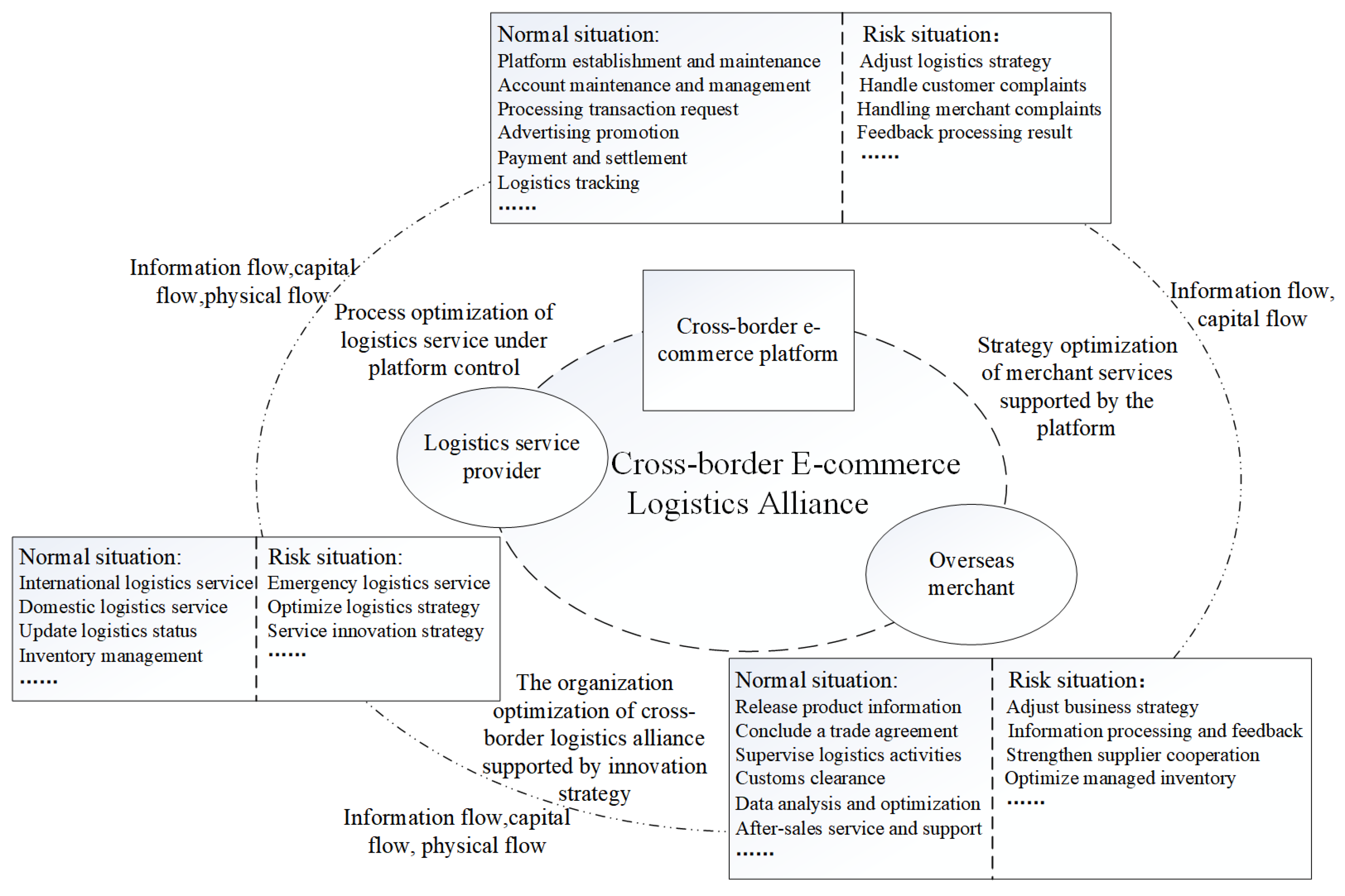


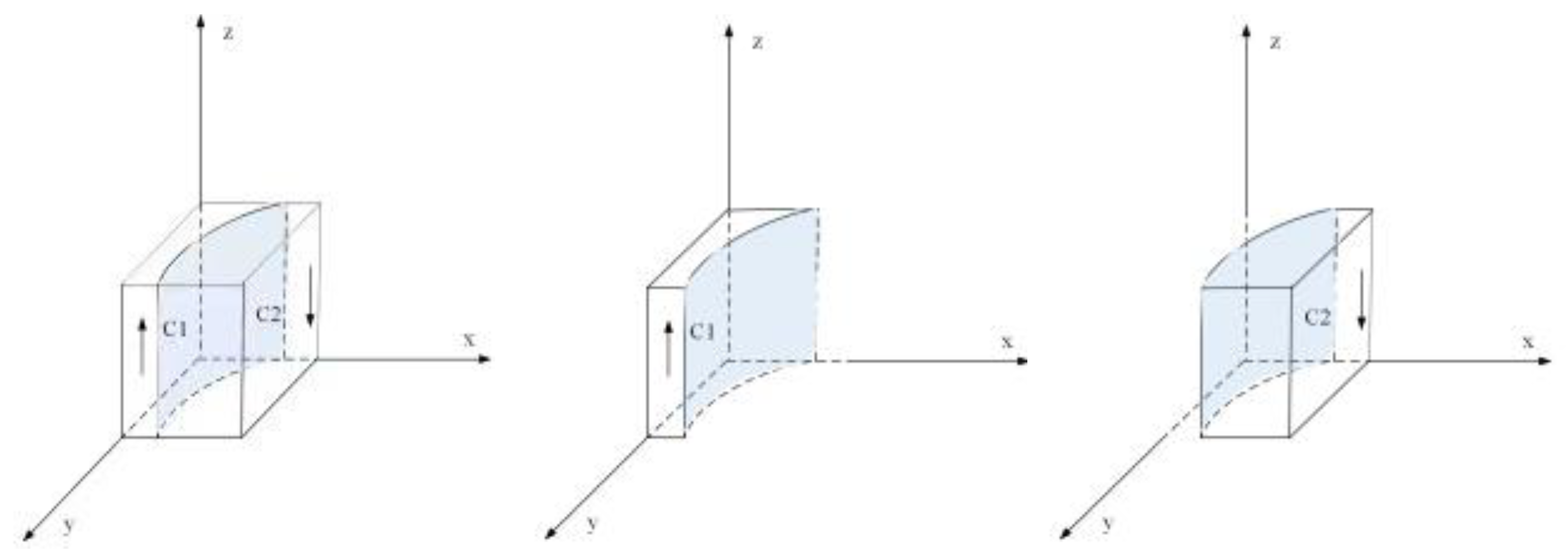
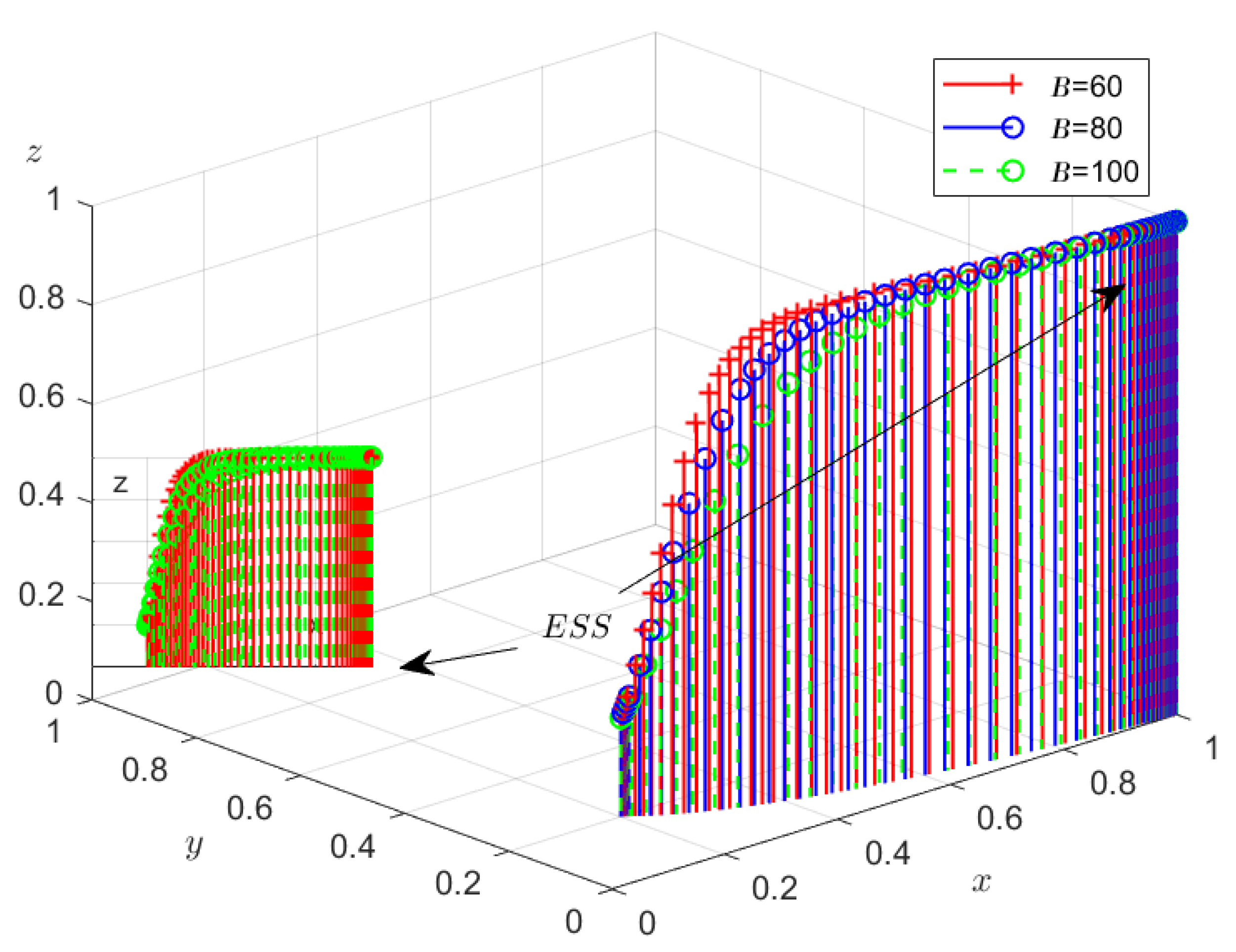
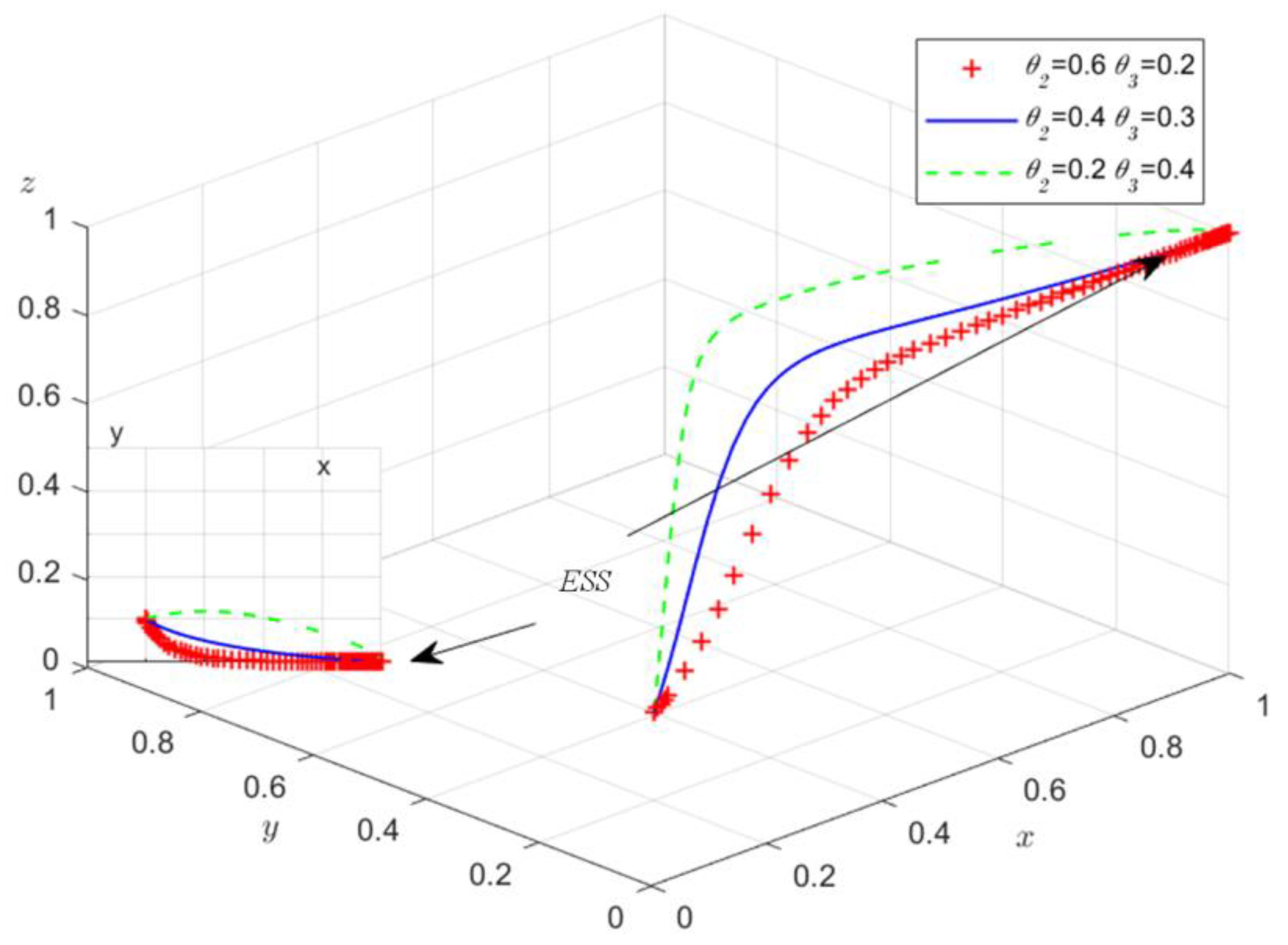
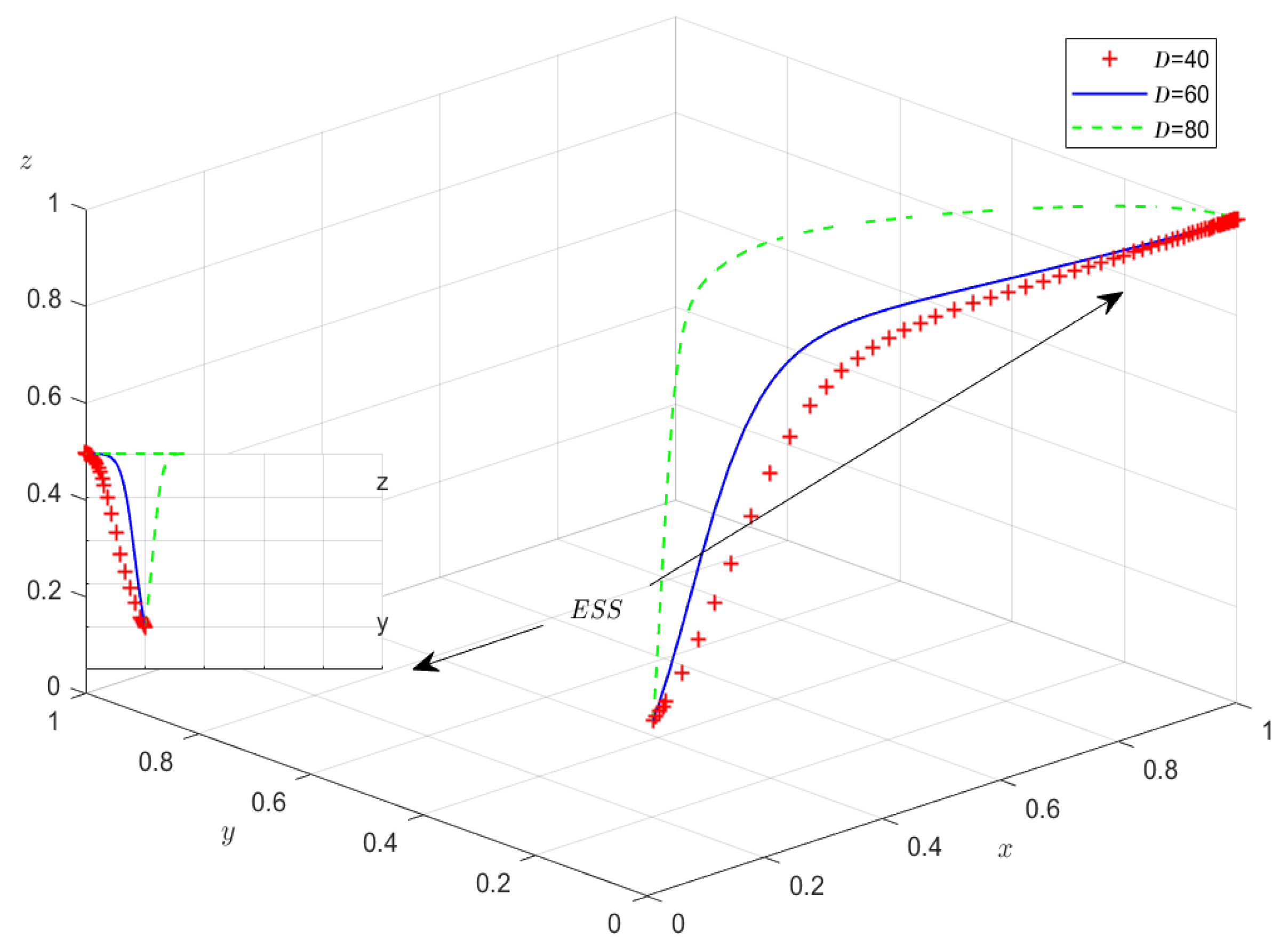
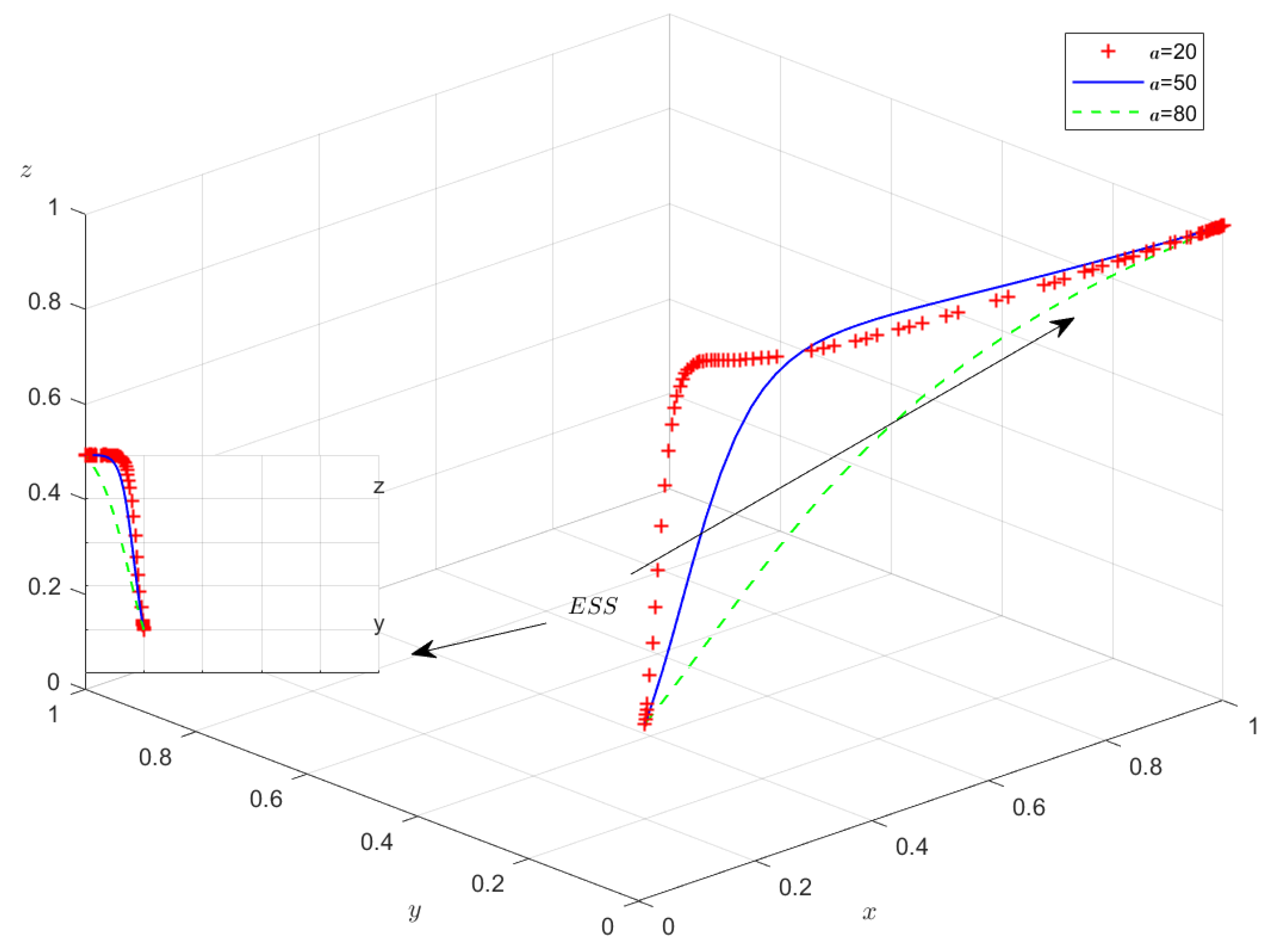
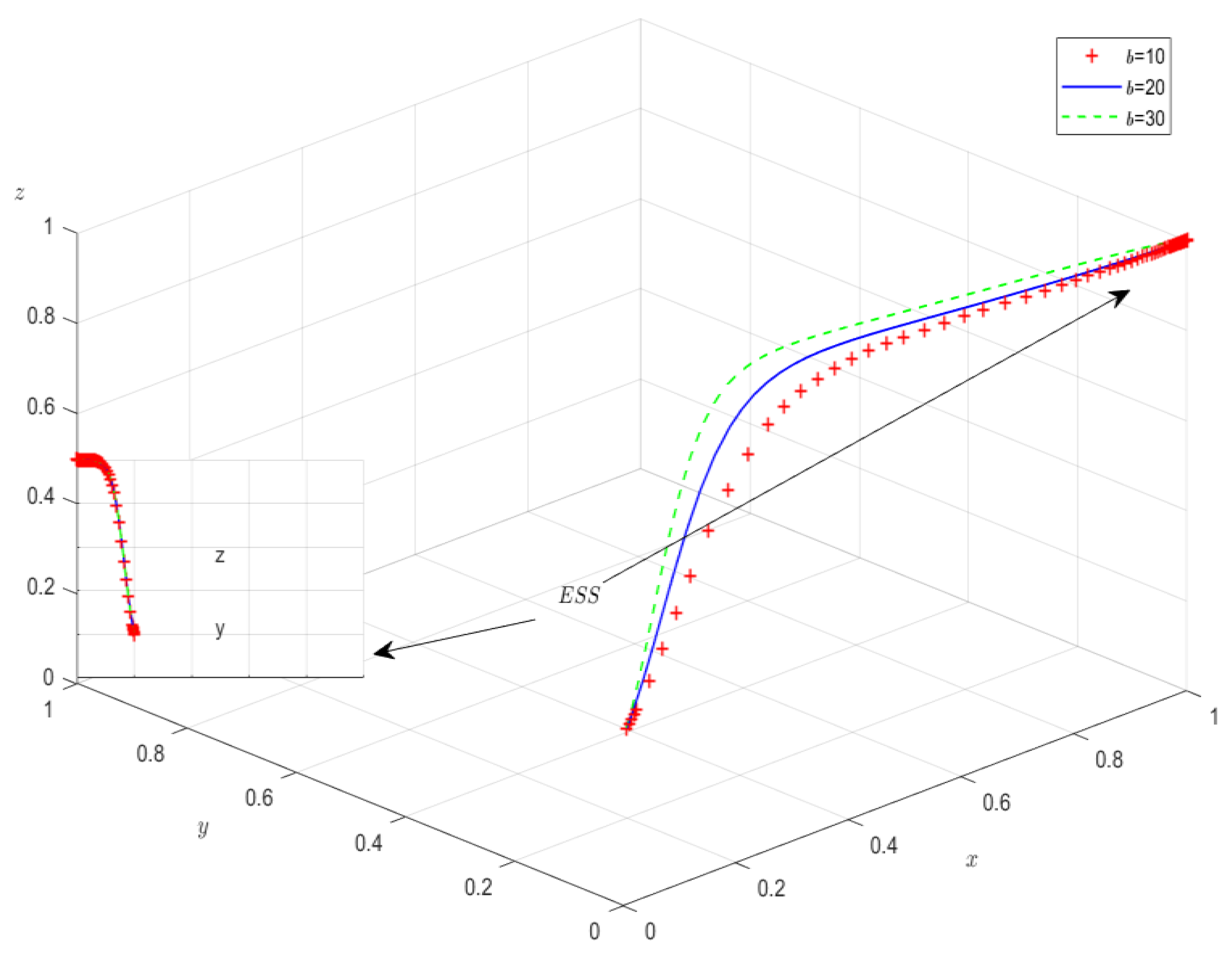
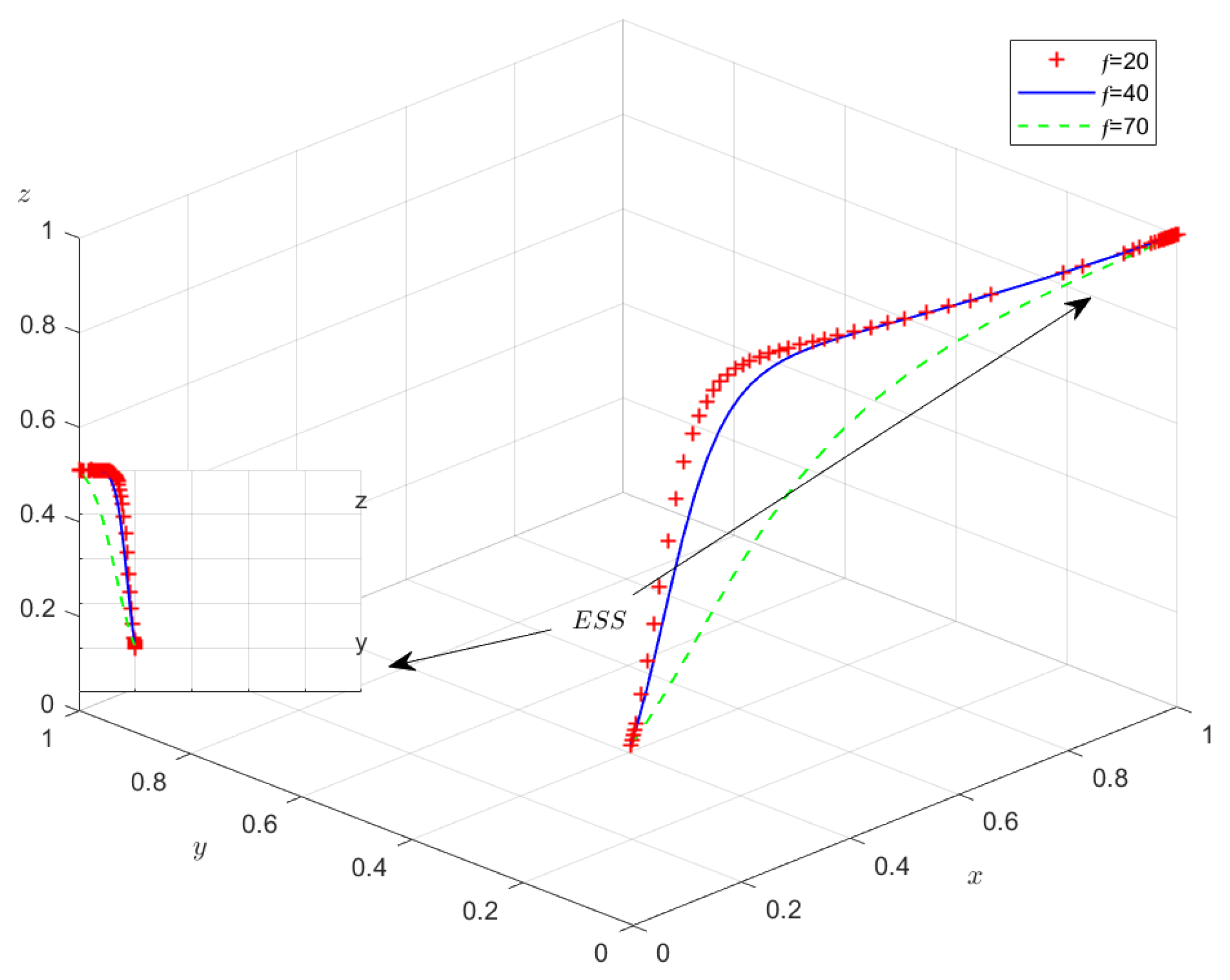
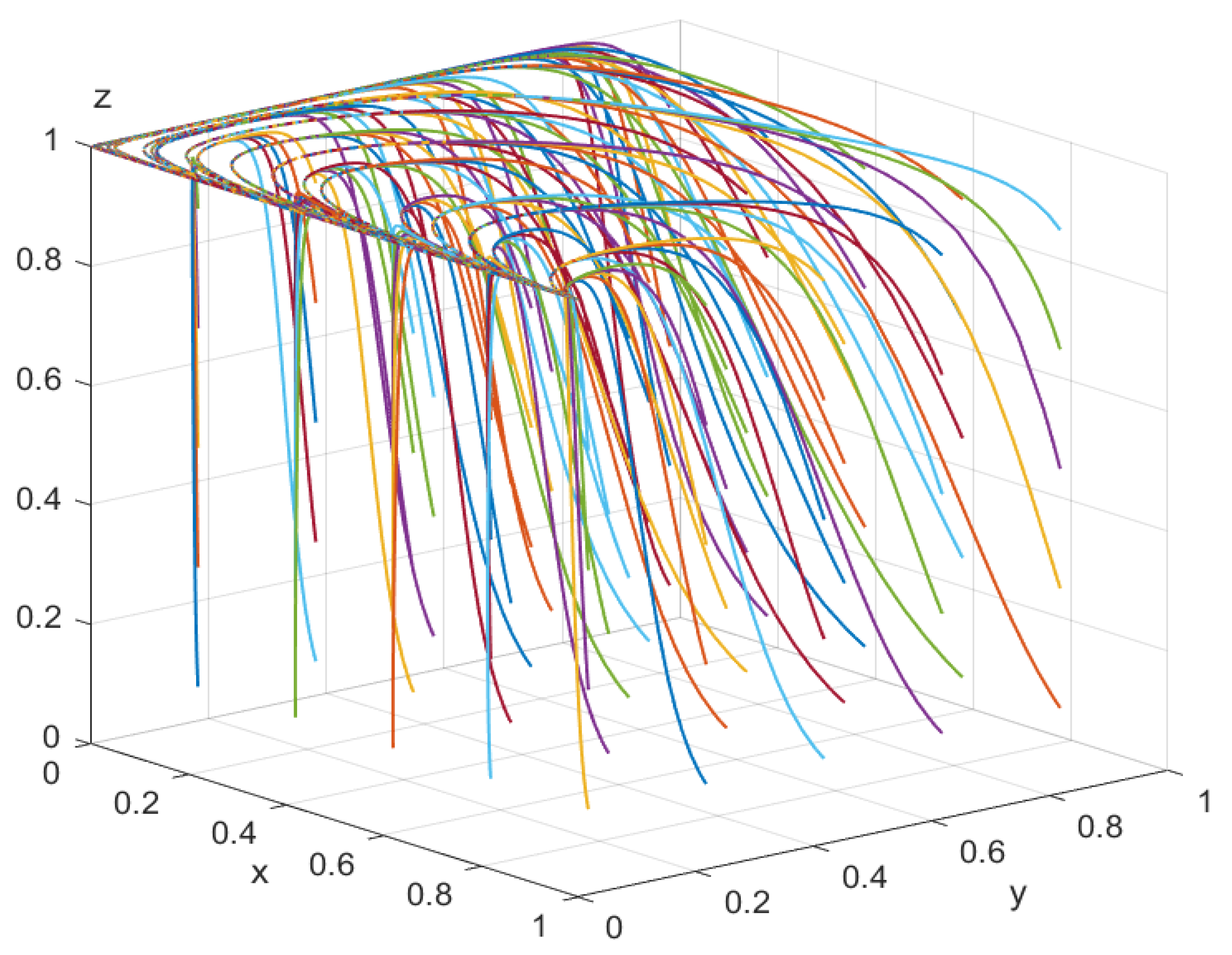
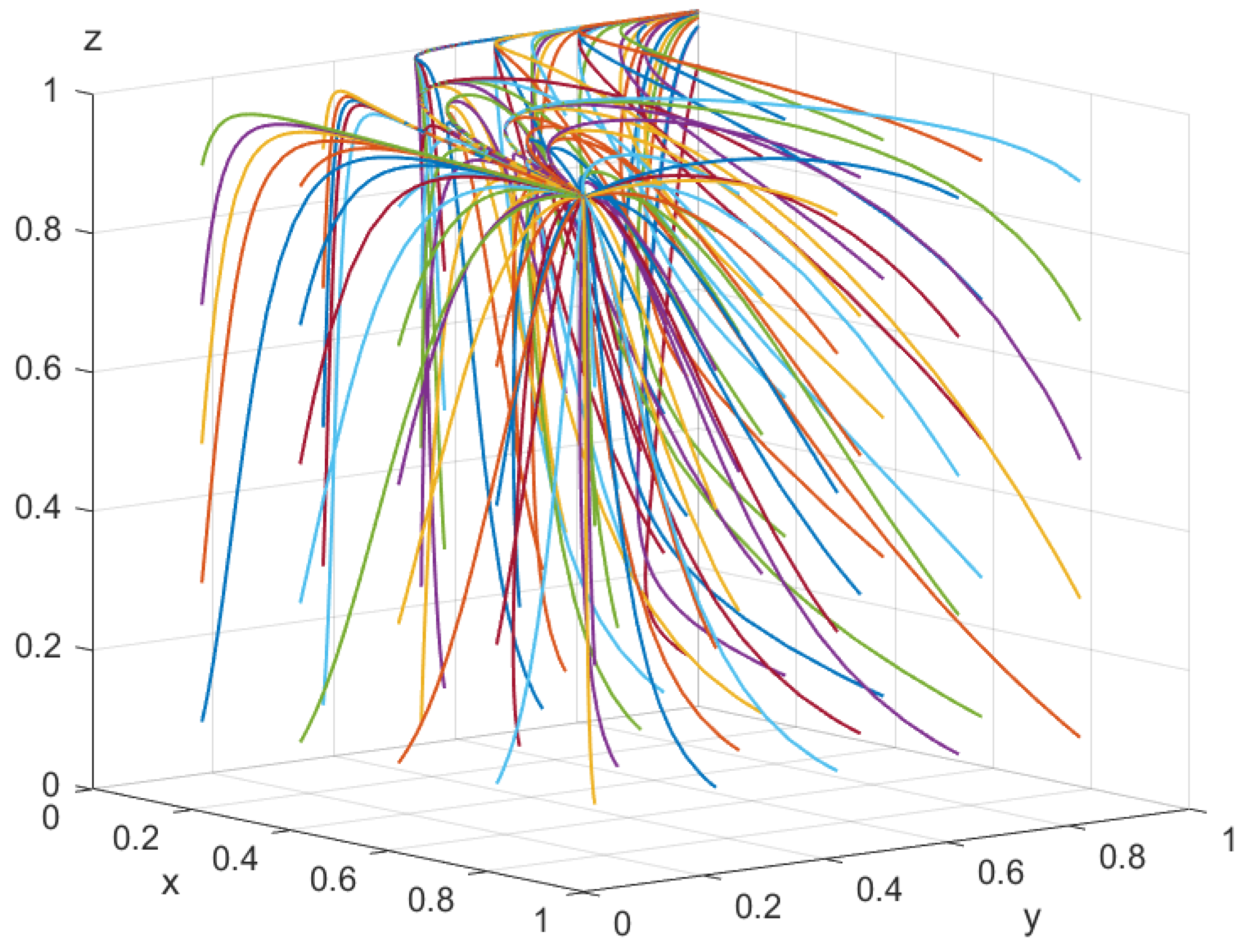
| Game Player | Parameter | Specific Meaning |
|---|---|---|
| Cross-border e-commerce platform | Direct benefits of cross-border e-commerce platforms under the alliance | |
| Disruption risk alliances share the risk costs of cross-border e-commerce platforms | ||
| The budget of implementing the innovative service strategy cross-border e-commerce platform under the alliance shall bear the cost | ||
| Punishment and potential losses in the platform when logistics service providers do not implement service innovation strategies and are complained about | ||
| When the logistics enterprise is not controlled, the compensation ruling of the merchant due to the supply chain risk | ||
| The control costs of cross-border e-commerce platforms on logistics service providers | ||
| Logistics service provider | Direct benefits of logistics service providers under the alliance | |
| Disruption risk alliance shares the risk cost of logistics service providers | ||
| The budget of the logistics service provider to implement the innovation service strategy under the alliance bears the cost | ||
| Customer losses incurred under the risk of supply chain disruption | ||
| The possibility of not pursuing a service innovation strategy and being complained about for disruption risk | ||
| Overseas merchant | Direct income of overseas merchants under the alliance | |
| Break the risk alliance to share the risk cost of foreign merchants | ||
| The cost of implementing the innovative service strategy under the alliance shall be borne by the budget of overseas merchants | ||
| Logistics service providers do not carry out service innovation strategy, which brings additional losses to merchants | ||
| The opportunity cost of merchants joining the alliance | ||
| Customer losses incurred under the risk of supply chain disruption |
| Alliance Members (Game Players) | Cross-Border e-Commerce Platform | ||||
|---|---|---|---|---|---|
| Control (x) | Out of Control (1 − x) | ||||
| Logistics Service provider | Carry out Service Innovation strategy (y) | Overseas merchant | Participate in cooperation (z) | Aα1 − Bβ1 − Cθ1 − c | Aα1 − Bβ1 − Cθ1 |
| Aα2 − Bβ2 − Cθ2 | Aα2 − Bβ2 − Cθ2 − b | ||||
| Aα3 − Bβ3 − Cθ3 − f | Aα3 − Bβ3 − Cθ3 − f + b | ||||
| non-cooperation (1 − z) | Aα1 − Bβ1 − Cθ1 – c | Aα1 − Bβ1 − Cθ1 | |||
| Aα2 − Bβ2 − Cθ2 | Aα2 − Bβ2 − Cθ2 − b | ||||
| −(1 − γ)D | 0 | ||||
| No service Innovation strategy (1 − y) | Overseas merchant | Participate in cooperation (z) | Aα1 − Bβ1 − c + ad | Aα1 − Bβ1 | |
| Aα2 − Bβ2 − γD − ad | Aα2 − Bβ2 − γD − b | ||||
| Aα3 − Bβ3 − e − f − (1 − γ)D | Aα3 − Bβ3 − e − f + b − (1 − γ)D | ||||
| non-cooperation (1 − z) | Aα1 − Bβ1 − c + ad | Aα1 − Bβ1 | |||
| Aα2 − Bβ2 − γD − ad | Aα2 − Bβ2 − γD − b | ||||
| −e − (1 − γ)D | −e − (1 − γ)D | ||||
| Equilibrium Point | Jacobian Matrix Eigenvalues | Hypothesis 1 | Hypothesis 2 | ||
|---|---|---|---|---|---|
| λ1, λ2, λ3 | Eigenvalue Symbol | Stability | Eigenvalue Symbol | Stability | |
| E1(0,0,0) | γD − Cθ2, ad − c, Aα3 − Bβ3 + b − f | +,+,+ | Saddle point | −,+,+ | Unstable point |
| E2(0,1,0) | Cθ2 − γD,−c, Aα3 − Bβ3 + Cθ3 + b − f | −,−,+ | Unstable point | +,−,+ | Unstable point |
| E3(0,0,1) | γD − Cθ2, ad − c, Bβ3 − Aα3 − b + f | +,+,− | Unstable point | −,+,− | Unstable point |
| E4(0,1,1) | Cθ2 − γD,−c, Bβ3− Aα3 − Cθ3 − b + f | −,−,− | ESS | +,−,− | Unstable point |
| E5(1,0,0) | c − ad, Aα3 − Bβ3 − f, b − Cθ2 + γD − ad | −,+,− | Unstable point | −,+,− | Unstable point |
| E6(1,0,1) | c − ad, Bβ3 − Aα3 + f, b − Cθ2 + γD − ad | −,−,− | ESS | −,−,− | ESS |
| E7(1,1,0) | c,Cθ2 − b − γD + ad, Aα3 − Bβ3 + Cθ3 + D − f – γD | +,−,+ | Unstable point | +,+,+ | Saddle point |
| E8(1,1,1) | c,Cθ2 − b − γD + ad, Bβ3 − Aα3 − Cθ3 − D + f + γD | +,−,− | Unstable point | +,+,− | Unstable point |
| E9(x1, y1,0) | Aα3 − Bβ3 + b − f + y1Cθ3 − bx1 + Dx1y1 − γDx1y1,λ1,λ2 | +,×,− | Indeterminacy | +,×,− | Indeterminacy |
| E10(x2, y2,1) | Bβ3 − Aα3 − b + f − y1Cθ3 + bx1 − Dx1y1 + γDx1y1, λ3, λ4 | −,×,− | Indeterminacy | −,×,− | Indeterminacy |
Disclaimer/Publisher’s Note: The statements, opinions and data contained in all publications are solely those of the individual author(s) and contributor(s) and not of MDPI and/or the editor(s). MDPI and/or the editor(s) disclaim responsibility for any injury to people or property resulting from any ideas, methods, instructions or products referred to in the content. |
© 2023 by the authors. Licensee MDPI, Basel, Switzerland. This article is an open access article distributed under the terms and conditions of the Creative Commons Attribution (CC BY) license (https://creativecommons.org/licenses/by/4.0/).
Share and Cite
Yang, X.; Jiang, H.; Chen, W. Evolutionary Game Analysis of Cross-Border E-Commerce Logistics Alliance Subject Considering Supply Chain Disruption Risk. Sustainability 2023, 15, 16350. https://doi.org/10.3390/su152316350
Yang X, Jiang H, Chen W. Evolutionary Game Analysis of Cross-Border E-Commerce Logistics Alliance Subject Considering Supply Chain Disruption Risk. Sustainability. 2023; 15(23):16350. https://doi.org/10.3390/su152316350
Chicago/Turabian StyleYang, Xiaochun, Huiyuan Jiang, and Wenxia Chen. 2023. "Evolutionary Game Analysis of Cross-Border E-Commerce Logistics Alliance Subject Considering Supply Chain Disruption Risk" Sustainability 15, no. 23: 16350. https://doi.org/10.3390/su152316350
APA StyleYang, X., Jiang, H., & Chen, W. (2023). Evolutionary Game Analysis of Cross-Border E-Commerce Logistics Alliance Subject Considering Supply Chain Disruption Risk. Sustainability, 15(23), 16350. https://doi.org/10.3390/su152316350





